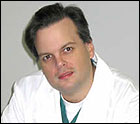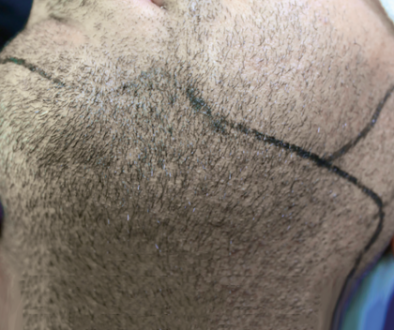Will Follicular Unit Extraction Completely Replace Strip Hair Transplants in the Future?
This question, answered by Coalition surgeon Dr. Alan Feller, was asked by a member of our Hair Restoration Social Community and Discussion Forums:
Do you think in the future follicular unit extraction (FUE) will fully take the place of strip surgery or do you think FUE will just be used as an added alternative?
 I never thought that FUE could replace follicular unit transplantation (FUT) because of the trauma associated with FUE compared to strip.
I never thought that FUE could replace follicular unit transplantation (FUT) because of the trauma associated with FUE compared to strip.
FUE grafts undergo three detrimental forces that strip grafts just don’t:
1. Torsion- Twisting to the point of graft fracture
2. Compression- crushing
3. Traction- pulling apart.
Unfortunately, to date, there is no way to obtain a graft via FUE without experiencing these three forces. Some of the instruments I’ve developed minimize the forces, but don’t eliminate them. Some devices made by other doctors also minimize, but don’t eliminate.
Also, even if one could completely eradicate the three detrimental forces, the havoc large or multiple FUE sessions play on the donor area can be considerable.
After, say, 1500 grafts, the holes begin to coalese together to form one massive subdermal scar. Even though it may not be very noticable to the eye, the damage is done and it can and will limit the ability to obtain more follicular unit grafts in the future: even if strip is then utilized.
FUE definitely has its place, but only for small procedures or as an adjunct to strip surgery. I felt that way back in 2004 when this video was made, and I still believe the same today. Nothing since has convinced me to change this view.
Sure, there are some great FUE results out there, and I’m proud to have contributed to that number, but percentage-wise, FUE doesn’t hold a candle to the consistency of strip results.
The gold standard of hair transplant surgery is, and remains, quality strip surgery performed by an experienced surgical hair restoration team with a great track record. And nowadays there are plenty such clinics dotting the globe.
Dr. Alan Feller
____
David (TakingThePlunge) Forum Co-Moderator and Editorial Assistant for the Hair Restoration Forum and Social Network, the Coalition Hair Loss Learning Center, and the Hair Loss Q & A Blog.
Get Proven Hair Loss Treatments at the Best Prices by visiting our new Online Hair Loss Product Store
Technorati Tags: follicular unit extraction, FUE, follicular unit transplantation, FUT, follicular unit grafts, hair transplant, hair restoration




July 20, 2011 @ 12:05 am
Hi,
I agree with observations of Dr Bauman completely.I can compare present day resistance to FUE acceptance is high only among physicians and it is very much similar to the way laparoscopic surgery was received in late eighties and early nineties in my country.Things have changed to an extent that only limitation in laparoscopic surgery is now surgeon expertise and it had been extended to virtually everything.I am practising in North of India and there is huge demand for FUE procedures so much so that that it may be almost impossible to offer strip surgery 2-3 years down the line.Good thing is all new entrants to field are quicker to see this trend and are picking up this skill fast.
Any physician who has done strip and moved to FUE will find it difficult to go back to strip.
Sincerely
Dr BK Garg
MBBS,MS,MCh(Plastic)
New Delhi
June 17, 2011 @ 7:50 am
I applaud Dr. Feller for pointing out that FUE is a difficult procedure to master and that there are certainly different skills and concerns to be addressed when learning the technique.
However, having performed linear harvesting since 1995 and FUE since 2001, I can tell you that there are MAJOR forces involved with strip harvesting/microscopic dissection, which can ALSO damage grafts–not to mention sloppy implantation techniques. All you need to do is watch the technicians perform a microscopic dissection of a strip to see the pulling and tugging required to achieve ‘clean’ follicular units!
As early as the ISHRS Orlando Live Surgery workshop in 2004 and recently as the ISHRS Orlando Live Surgery Workshop 2010 (in conjunction with Dr. James Harris), numerous lectures and live internet events, it has been demonstrated that FUE grafts could be harvested in a gentle fashion, sorted, then implanted with an extremely high rate of successful growth. These successes have been duplicated many times and by many surgeons around the world using a variety of instruments and techniques. Anyone can do a simple internet search to see videos of physicians from around the world performing FUE procedures successfully and patients proudly displaying their FUE results.
Personally, I think it is misleading for to make blanket statements about “torsion, compression, traction,” etc. when perhaps those same forces are at play with microscopic dissection–often to a MUCH GREATER DEGREE than with FUE. I’m not saying those forces do not exist, but their importance will vary depending on the surgeon and his/her staff.
Educated patients understand that hair transplant grafts are fragile–no matter how they are harvested–and will therefore need to choose their doctor and his team carefully. Why do you think we go through so much trouble and expense with chilled hypothermasol or PRP, etc. to keep grafts viable and train our staff to be gentle!?
I think it’s important to note that because technology changes so fast, what is the ‘gold-standard’ in one practice is simply NOT the ‘gold-standard’ in another.
For example, a recent public conversation on a hair transplant physician internet forum based in India, Dr. Mario Marzola mentioned that he believes the worldwide tide has already turned to FUE and linear harvesting will be near extinction in five years. Just look at the recent FUE conference in Turkey. I’ll bet more FUE-only conferences are on the horizon!
Patients need to do their research amongst ALL hair restoration physicians–and find out what works best in THEIR hands. Like many FUE practices, we routinely perform 3000+ FUE grafts per session–what patients are calling “Mega-FUE.” If a practice cannot perform these kinds of procedures successfully, then strip will always look like a more efficient option. Said another way, I think that until the doctor can perform 1500 FUE easily, he/she will always lean toward strip harvesting as a preferred method.
There will likely always be ‘some’ place for a more invasive strip surgery (similar to scalp expanders/flaps/reductions for trauma) but like laparoscopic surgery in abdominal cases and robotic pelvic surgery in urology/gynecology, less invasive is here to stay.
Consider this, doctors entering the field of hair transplant today are not likely to start off with a strip harvest. They are learning FUE and with enough practice they will eventually become great at it. Devices like Rotocore, NeoGraft-FUE, Feller Punch, Harris SAFE Punch and robotic-assisted ARTAS-FUE will continue to make FUE easier, more efficient, less traumatic, more accurate and offer more consistent FUE results for patients over time.
The key for the future, however, is eventually not how the grafts are being harvested (it might be a robot!), but how artistically they are implanted…
Sincerely,
Alan J. Bauman, M.D.
Bauman Medical Group
Diplomate, American Board of Hair Restoration Surgery